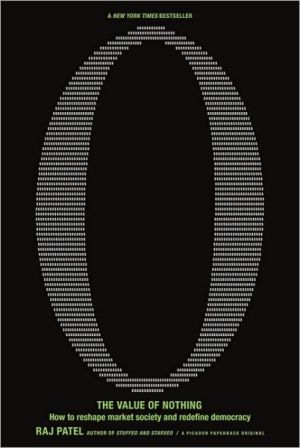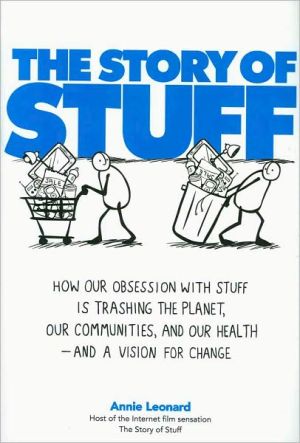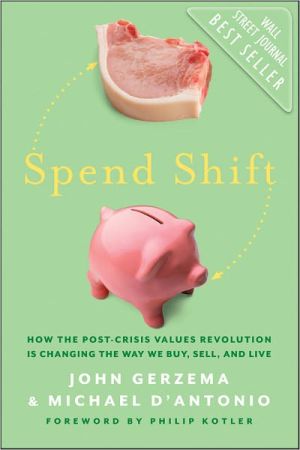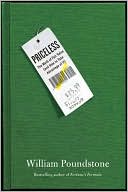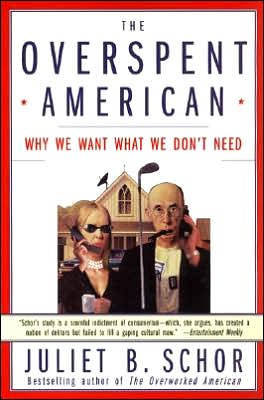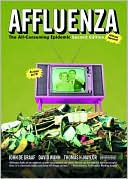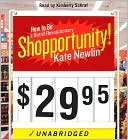The Value of Nothing
"A deeply though-provoking book about the dramatic changes we must make to save the planet from financial madness."--Naomi Klein, author of The Shock Doctrine Opening with Oscar Wilde's observation that "nowadays people know the price of everything and the value of nothing," Patel shows how our faith in prices as a way of valuing the world is misplaced. He reveals the hidden ecological and social costs of a hamburger (as much as $200), and asks how we came to have markets in the first place....
Search in google:
Raj Patel, the author of Stuffed and Starved, is an activist and an academic who has been hailed as "a visionary" for his prescience about the food crisis and solutions to it. Publishers Weekly Expanding on his analysis and recommendations in Stuffed and Starved, which located the horrifying imbalance in the world's food system in its profit-driven framework, activist and academic Patel critiques “free market culture” at a moment of universal crisis, both economic and environmental. Beginning with a historically grounded account of market society's operative assumptions, “the way capitalism sets the terms of value,” Patel takes aim at the notion of “Homo economicus”: a vision of human beings as self-interested utility-maximizers integral to market society's dollar-valuation of everything. Through a shrewd and absorbing discussion, Patel exposes the flaws in the “model of the world in which people are... prepared to override their own better judgment in service of their selfish natures” and the nominal separation of the economy and the state, describing the relationship as compromised but also more “plastic” then we are often led to believe. With due attention to the developing world as well as Europe and North America, the author offers examples of the “countermovement” underway and urges us to build on a vision of ourselves far more extensive, generous and hopeful than that confined to market society's Homo economicus. (Jan.)
PART ONE\ Nowadays people know the price of everything and the value of nothing.\ —OSCAR WILDE, The Picture of Dorian Gray\ (ONE)\ THE FLAW\ Now I a fourfold vision see,\ And a fourfold vision is given to me;\ ’Tis fourfold in my supreme delight,\ And threefold in soft Beulah’s night,\ And twofold Always. May God us keep\ From Single vision, & Newton’s sleep!\ —WILLIAM BLAKE, "Poems from Letters"\ If war is God’s way of teaching Americans geography, recession is His way of teaching everyone a little economics.\ The great unwinding of the financial sector showed that the smartest mathematical minds on the planet, backed by some of the deepest pockets, had not built a sleek engine of permanent prosperity but a clown car of trades, swaps and double dares that, inevitably, fell to bits. The recession has not come from a deficit of economic knowledge, but from too much of a particular kind, a surfeit of the spirit of capitalism. The dazzle of free markets has blinded us to other ways of seeing the world. As Oscar Wilde wrote over a century ago: "Nowadays people know the price of everything and the value of nothing." Prices have revealed themselves as fickle guides: The 2008 financial collapse came in the same year as crises in food and oil, and yet we seem unable to see or value our world except through the faulty prism of markets.\ One thing is clear: The thinking that got us into this mess is unlikely to rescue us. It might come as some consolation to know that even some of the most respected minds have been forced to puzzle over their faulty assumptions. Perhaps the most pained admission of ignorance happened in a crowded room in front of the House Committee on Oversight and Government Reform when, on October 23, 2008, Alan Greenspan described the failure of his worldview.\ Greenspan was one of the acknowledged legislators of the world’s economy over the past nineteen years in his role as chairman of the Federal Reserve. A card-carrying member of the free market brigade, he used to sit at the feet of Ayn Rand who, although largely unknown outside the United States, remains influential long after her death in 1982. Her 1957 book Atlas Shrugged, in which heroic business moguls fight the scourge of government officials and union organizers, has once again scaled the best-seller lists. Regarding altruism as "moral cannibalism," Rand was the cheerleader for an extreme free market libertarian school of thought, which she called "Objectivism." Drawn into her circle by this heady philosophy, Greenspan earned himself the nickname "the Undertaker" for his jolly demeanor and dress sense. When Greenspan chose a career in government, it was rather like a hippie joining the marines, a lapse that his former friends could never forgive. Despite this, Greenspan remained largely faithful to Rand’s philosophy, continuing to believe that egoism would lead to the best of all possible worlds, and that any form of restraint would result in disaster.\ At the end of 2008, Greenspan was summoned to the U.S. Congress to testify about the financial crisis. His tenure at the Fed had been long and lauded, and Congress wanted to know what had gone wrong. As he began to read his testimony, Greenspan looked exhausted, his skin jowly and sagging, as if the vigor that once kept him taut had all been spent. But he came out swinging. In the first round, he took aim at the information he’d been working with. If only the input had been right, the economic models would have worked, and the predictions would have been better. In his words,\ A Nobel Prize was awarded for the discovery of the pricing model that underpins much of the advance in derivatives markets. This modern risk management paradigm held sway for decades. The whole intellectual edifice, however, collapsed in the summer of last year because the data inputted into the risk management models generally covered only the past two decades, a period of euphoria. Had instead the models been fitted more appropriately to historic periods of stress, capital requirements would have been much higher and the financial world would be in far better shape today, in my judgment.1\ This is a garbage-in-garbage-out argument: The model worked just fine, but the assumptions about risk and data, based only on the good times past, were faulty and so the output was correspondingly wrong. Greenspan’s nemesis on the panel, Henry Waxman, pushed him to a deeper conclusion, in this remarkable exchange:\ WAXMAN: The question I have for you is, you had an ideology, you had a belief that free, competitive—and this is your statement—"I do have an ideology. My judgment is that free, competitive markets are by far the unrivalled way to organize economies. We have tried regulation, none meaningfully worked." That was your quote. You had the authority to prevent irresponsible lending practices that led to the subprime mortgage crisis. You were advised to do so by many others. And now our whole economy is paying the price. Do you feel that your ideology pushed you to make decisions that you wish you had not made?\ GREENSPAN: Well, remember, though, what an ideology is. It’s a conceptual framework with [sic] the way people deal with reality. Everyone has one. You have to. To exist, you need an ideology. The question is, whether it is accurate or not. What I am saying to you is, yes, I found the flaw, I don’t know how significant or permanent it is, but I have been very distressed by that fact.\ WAXMAN: You found a flaw?\ GREENSPAN: I found a flaw in the model that I perceived is the critical functioning structure that defines how the world works, so to speak.\ WAXMAN: In other words, you found that your view of the world, your ideology, was not right, it was not working.\ GREENSPAN: Precisely. That is precisely the reason I was shocked, because I had been going for 40 years or more with very considerable evidence that it was working exceptionally well.\ The flaw, to be clear, wasn’t a minor one of shoddy data. Nor was it the bigger Black Swan problem that writers like Nassim Taleb discuss, a problem of failing to account for highly unlikely events that, should they happen, involve catastrophic consequences. Greenspan’s flaw was more fundamental still. It warped his view about how the world was organized, about the sociology of the market. And Greenspan is not alone. Larry Summers, the president’s senior economic advisor, has had to come to terms with a similar error—his view that the market was inherently self-stabilizing has been "dealt a fatal blow.’ "2 Hank Paulson, Bush’s treasury secretary, has shrugged his shoulders with similar resignation. Even Jim Cramer from CNBC’s Mad Money admitted defeat: "The only guy who really called this right was Karl Marx.’ "3 One after the other, the celebrants of the free market are finding themselves, to use the language of the market, corrected.\ The extent of Greenspan’s admission has passed most of us by. If you trawl the op-ed pages of the financial press, you’ll find plenty of analysis that fits Greenspan’s first gambit, with pundits offering stories about how risk was incorrectly priced (which it was), how the lack of regulation allowed the panic to feed back into the financial system (which it has), how the incentive structures rewarded traders who were able to push financial risk far into the future (which they did) and how free market ideologues removed the sorts of circuit-breaking policies that might today have helped (and they did that too). But these are all it-could-have-been-fixed-if-we’d-planned-better responses. I am not sure that we’re able to comprehend what Greenspan’s admission might really mean for us. It would be too big a shock to have the fundamentals of policy in both government and the economy proved wrong, and to have nothing with which to replace them.\ It’s as if one day, you were to wake up and find yourself transformed into a cockroach.4 This is the premise of Franz Kafka’s novella Metamorphosis. In the first sentence, a young salesman named Gregor Samsa wakes up, after a night of bad dreams, to find that he has turned into an enormous bug. Gregor Samsa’s response is revealing, telling us a little bit more about ourselves than we’d like. For what does Samsa do when he discovers he’s a bug? He doesn’t scuttle from his room screaming, or ponder how this happened, or what his transformation means, and what he might become tomorrow. His response is essentially this: "Poor me! How am I going to keep my job?"\ Which is almost exactly how we’ve reacted to this economic crisis.\ While no one has yet woken up in the body of a bug, we have all found ourselves in a world turned upside down, where everything we were told was to our advantage has turned out to be its opposite. Greenspan’s "flaw" has profound repercussions—to understand it fully would mean a complete reappraisal of the way we conduct our lives. We would need not only a new way of mooring our expectations of our society and our economy, one based on richer assumptions about human nature, but also a different ideology governing the exchange of goods and services.\ Prices do some heavy ideological lifting in Greenspan’s world. They provide a way to see and know the collective wants and resources of our small planet. This is Friedrich Hayek’s economic philosophy, in which prices are the tendrils through which wants and needs are communicated. Science fiction fans will already be familiar with what this looks like. In The Matrix, liberated humans (and the programs who hunt them) can see the world in its raw form, as a digital rain of symbols and signs. This is the science fiction that governs economic fact. Data pelting down monitors is what the masters of the universe on the global financial exchanges stare at, their eyes darting from screen to screen, trying to see through the world and profit from it. In The Matrix, the signs were a simulation of the real world, hiding more than they revealed. The trouble is that this unreliable digital ticker tape has now become a central prop in the drama of modern commerce.\ Consider the fate of Volkswagen, which at the end of October 2008 managed briefly to become the world’s most valuable corporation without having to sell a single vehicle. With the economy still in free fall, traders on stock-market floors were taking a dim view of Volkswagen. They looked at their screens and concluded that, just like every other auto manufacturer, Volkswagen was heading for tough times. Imagine you’re a trader who feels in your bones that the stock price can only fall. One way to cash your hunch in is to sell Volkswagen stock today, and buy it back when the price falls. Since you don’t walk around with Volkswagen stock falling out of your pockets, you’ll turn to someone who does, like an institutional investor. You borrow their stock, for a price, and promise to return all of it very soon. The institutional investor is happy because they make money from lending out the stock, which they will get back in one piece. You’re happy because you can sell this stock, wait for the price to fall, buy it back and, with the profit, not only pay back the institutional investor, but make the next installment on your yacht in Monaco. This practice is called "shorting."\ The trouble was that Volkswagen’s rival, Porsche, had started quietly buying Volkswagen stock, aiming to secure 75 percent of the company. When the scale of Porsche’s buying spree came to light, it became rapidly clear that there was little of the company left to trade. With Porsche sucking up all the shares, the price for Volkswagen didn’t drop. Traders were selling borrowed stock to Porsche, and when Porsche announced its intentions to hold the stock, traders panicked. This led to a "short squeeze," a flocking of investors looking to cover the ill-conceived bets that they’d paid for with stock that they didn’t own. They’d wagered that Volkswagen’s price, like that of any other car company in a recession, would fall. When it became clear that even if Volkswagen wasn’t doing well in the car market, its share price was nonetheless defying gravity, the speculators rushed to buy before the price went any higher.\ Their combined purchases drove the price of shares up further. So high did the price rise that Volkswagen entered the DAX 30 index of the largest corporations on the German bourse. This triggered another buying spree, driven not by stock-market gamblers, but by their polar opposites—conservative institutional investors. Pension funds, for instance, invest with an eye to long-term returns; they prefer a slow and certain accumulation of wealth rather than risky bets. One way that they keep their portfolio on an even keel is to buy shares in nothing but blue chip corporations, ones that are guaranteed to be least susceptible to the shocks that stocks are heir to, ones that are in the top, say, thirty corporations traded in the open market. When Volkswagen joined the ranks of the DAX 30, a flock of institutional investors automatically wanted in. So they bought Volkswagen shares at whatever price they could find them. The result? The price per share went from €200 to €1,000 in a week—an increase in company value of €300 billion (£244 billion; $386 billion). It made Volkswagen, briefly, bigger than Exxon-Mobil (with a book value of a mere $343 billion). And for this, the company didn’t raise a finger.\ In the end, the rules on the DAX were changed, the price settled down and, in 2009, Volkswagen bought Porsche. It is easy enough to tell this story as one where institutional investors got caught with their pants down, where there was imperfect information about the size of the market, where the rules of different short-run and long-run games tangled. But look more closely. Underwriting this version of the story is a conceptual structure that lies beneath every story of excess and crash. The very notion of a bubble relies on the premise that when the bubble pops, things return to a normal state, a situation of price reflecting value more accurately. This is the story told after every boom and bust, from the South Sea Bubble of 1720 to the housing catastrophe of 2008. There’s a widely shared opinion that normality will ultimately return to the world economy—but it’s a consensus view that rests on a story where bubbles are exceptions to the standard (and successful) procedures of market valuation. If those procedures themselves were flawed, as Greenspan suggests, then our faith in a gentle return to earth is misplaced, for there is and never has been any solid ground beneath our feet.\ Excerpted from The Value of Nothing by Raj Patel.\ Copyright © 2009 by Raj Patel.\ Published in January 2010 by Picador.\ All rights reserved. This work is protected under copyright laws and reproduction is strictly prohibited. Permission to reproduce the material in any manner or medium must be secured from the Publisher.
\ From the Publisher\ “With great lucidity and confidence in a dazzling array of fields, Patel reveals how we inflate the cost of things we can (and often should) live without, while assigning absolutely no value to the resources we all need to survive. This is a deeply thought-provoking book about the dramatic changes we must make to save the planet from financial madness -- argued with so much humor and humanity that the enormous tasks ahead feel both doable and desirable. This is Raj Patel's great gift: he makes even the most radical ideas seem not only reasonable, but inevitable. A brilliant book.”--Naomi Klein, author The Shock Doctrine\ "As we confront the crisis in the worldview of orthodox economics, Raj Patel offers us a whole new way to think about price and value. Bracingly written and full of surprises, The Value of Nothing is itself invaluable, showing us a path out of the darkness of the economic woods."--Michael Pollan, author of In Defense of Food and The Omnivore's Dilemma\ \ “With THE VALUE OF NOTHING, Raj Patel has done something of great value: in language utterly clear, concise, literate, and engaging, he takes readers through the murk and mess of the economy's collapse. He shows the hows and whys, how we seem bent on a repeat (no real substantive changes to the practices that got us where we are, at the policy level), but also how we, in our communities, if not larger concerted efforts, have some power to right the course. What Raj Patel did so brilliantly with food in STUFFED AND STARVED, he now does so with money and the economy.”--Rick Simonson, Elliott Bay Book Company\ “In this riveting eye-opener of a book, Patel dismantles with great fluidity and precision the reigning theory of the free market and its applications: how it creates in our global society deep inequalities of power, based solely on the diktat that our fundamental needs (water, decent food, housing, health care) are worthless because not profitable, and thus leading to economic chaos and a loss of community empowerment. But there is also hope in the emergence of social groups around the world who are insisting and reclaiming ‘the right to have rights’ through their democratic engagement. Patel brilliantly shows us how both a fairer society and a sustainable economy are possible as long as we are willing to seize back our freedom to choose from colluding governments and corporations. ‘The Value of Nothing’ should be required reading for any self-respecting citizen of the world.”--Marie du Vaure, Vroman’s Bookstore\ “It’s only January 2010, and we already have a candidate for the most important book of the year. Raj Patel’s The Value of Nothing takes aim at the conservative orthodoxy that has dominated American politics and economics for the last several decades, and he scores a direct hit.”--Bill Petrocelli, Book Passage\ \ \ \ \ \ Publishers WeeklyExpanding on his analysis and recommendations in Stuffed and Starved, which located the horrifying imbalance in the world's food system in its profit-driven framework, activist and academic Patel critiques “free market culture” at a moment of universal crisis, both economic and environmental. Beginning with a historically grounded account of market society's operative assumptions, “the way capitalism sets the terms of value,” Patel takes aim at the notion of “Homo economicus”: a vision of human beings as self-interested utility-maximizers integral to market society's dollar-valuation of everything. Through a shrewd and absorbing discussion, Patel exposes the flaws in the “model of the world in which people are... prepared to override their own better judgment in service of their selfish natures” and the nominal separation of the economy and the state, describing the relationship as compromised but also more “plastic” then we are often led to believe. With due attention to the developing world as well as Europe and North America, the author offers examples of the “countermovement” underway and urges us to build on a vision of ourselves far more extensive, generous and hopeful than that confined to market society's Homo economicus. (Jan.)\ \ \ Library JournalPatel (visiting scholar, Ctr. for African Studies, Univ. of California, Berkeley; Stuffed and Starved: The Hidden Battle for the World Food System) lays bare the social, political, and environmental damage caused by free markets and the commoditization of every facet of any market society. Such commoditization allows corporations to despoil the earth for short-term profit and has encouraged at least one economist to argue that antibigamy laws restrain the economic rights of ugly people by eliminating them as second spouses in the marriage marketplace. Markets, Patel declares, are a human construct and can be overthrown by humans; social rights to political participation, democratization, and popular control over the "commons"—air, soil, and water—offer the only viable alternative to the rape-and-pillage mentality of the market. VERDICT Patel debunks the myth that markets are the perfect form of social organization, effectively arguing that the tyranny they exert can and must be replaced by strategies benefiting all humanity and ensuring our very survival. This work is written calmly and sensibly enough that it could change some readers' minds, although it will leave free-market apologists spluttering. Highly recommended.—Duncan Stewart, Univ. of Iowa Libs., Iowa City\ \ \ \ \ Kirkus ReviewsA social scientist and activist makes a case for setting limits on our free-market society. Patel (Stuffed and Starved: The Hidden Battle for the World Food System, 2008) aims to shake readers out of complacent acceptance of the free-market economy, which has recently gone awry, with devastating consequences. Rather than hoping for a business-as-usual recovery, he writes, we must find new ways of valuing the world other than pricing it and letting the free market sort it out. Patel begins by tracing the roots of the market economy to the works of writers ranging from 19th-century political economist John Stuart Mill to 1992 Nobel laureate in economics Gary Becker, who argues that allowing the market to reign will ensure society's well-being. Patel derides Becker's work as encouraging policies that favor the powerful, notably corporations, which seek only to maximize profits and wind up creating significant social costs (degraded ecosystems, etc.) that society must bear. Noting that recent research indicates that humans have built-in desires for altruism and fairness as well as selfishness, the author describes innovative efforts to create a more compassionate society by such groups as La Via Campesina, an international peasant movement that supports family-farm-based sustainable agriculture. "From food rebellions to free software," he writes, "social movements are at the cutting edge of practical politics and economics, trying to create new ways to control the world without owning it." A tireless advocate for the developing world, Patel urges readers to consider a new vision of society based on an ethic of stewardship that subordinates property and markets to democratic concerns of equityand sustainability. Much of Patel's thinking is informed by a Buddhist world view that places the real value of something not on its ability to meet a desire or craving, but to meet the need for well-being. A pleasing invitation to act on our most benign impulses to create a sustainable future.\ \
